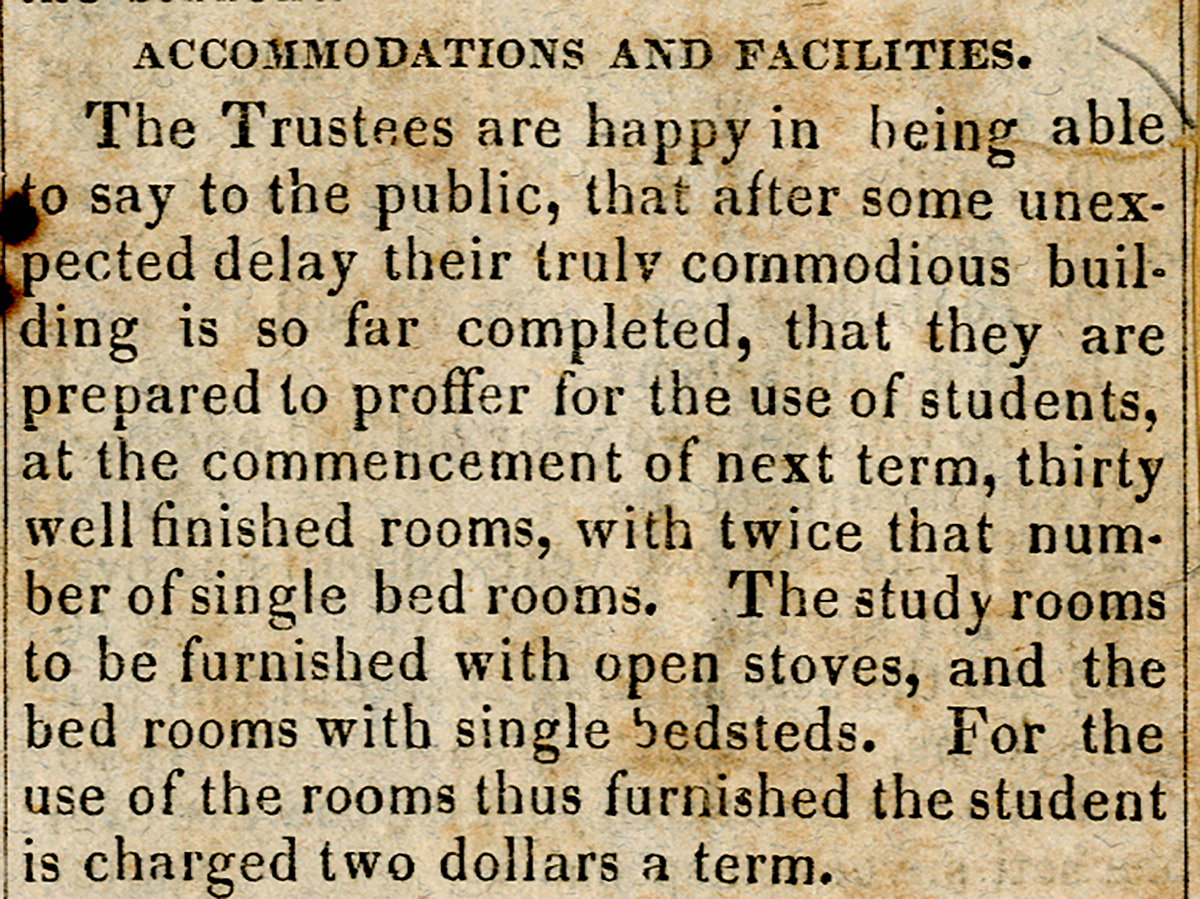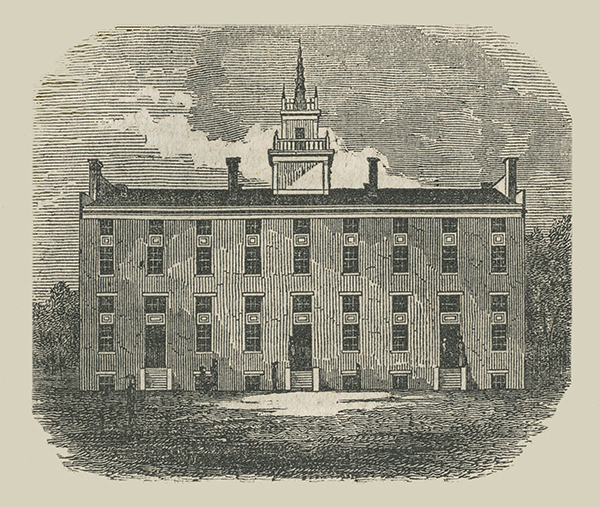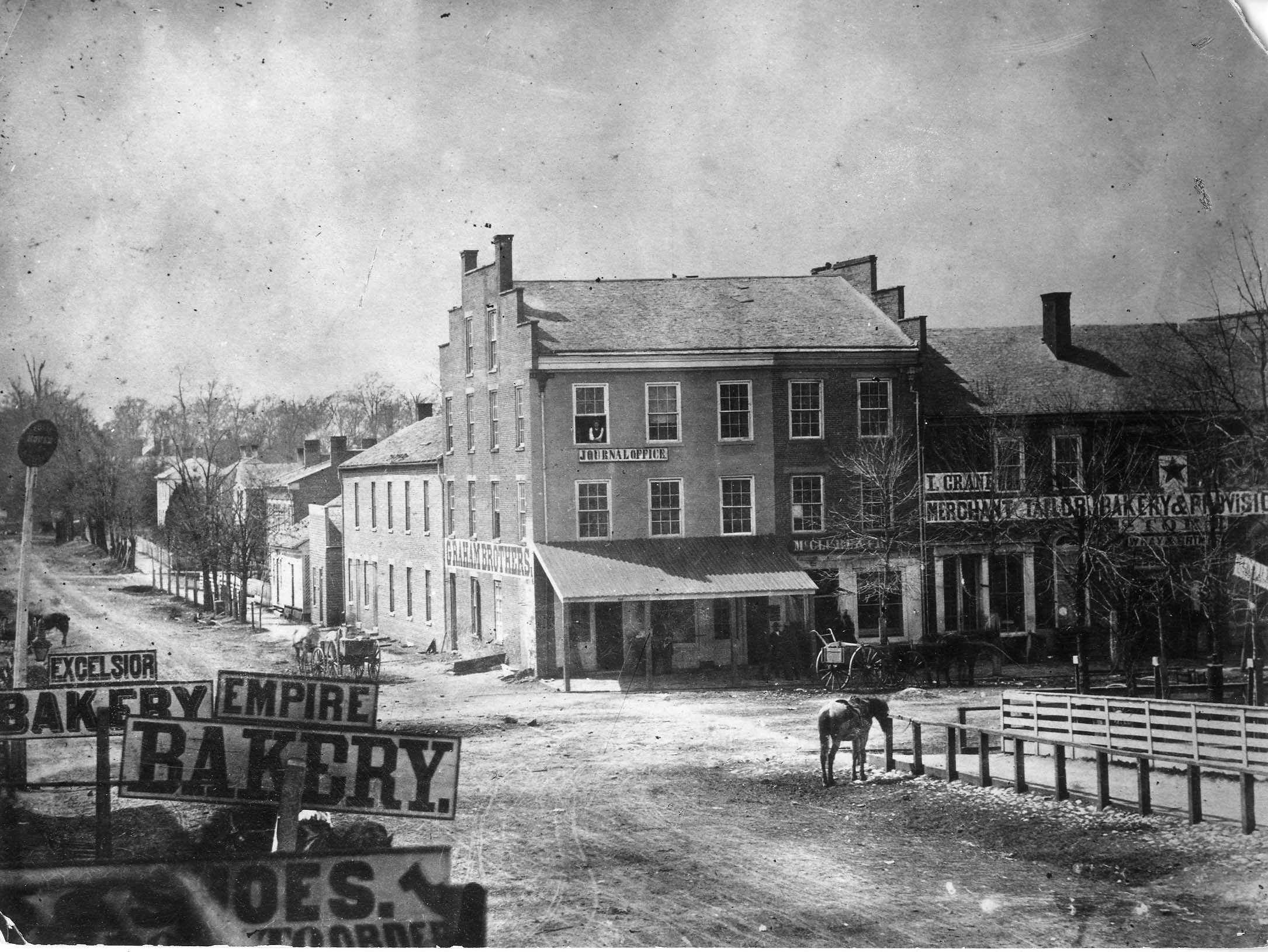
The year of 1838 held a great deal of promise. The new building was coming along nicely, plans were finalized for the first ever Wabash College commencement. As a fledgling college on the frontier, it might not surprise us that there were only two students who qualified to graduate. The usual course was two years of preparatory classes followed by four years of the classical course. These two students, Silas Jessup and Archibald Allen, finished in five.
The mood on campus later that summer might have been a good bit less celebratory due to an ever widening schism in the church of our founders. The Presbyterian Church in the United States was going through a great turmoil of faith. The sides became more clearly defined over time and boiled down to Old Lights and New Lights. The old lights were stricter, kept the Sabbath activity free and did not believe in educating through Sunday schools. The new lights were in favor of education wherever it might be shared, abolitionism and viewed their god as a more forgiving and loving god. Later that summer of 1838 a minister came over from Indianapolis to preach at the Presbyterian Church here in town. Imagine the distress the founders and early faculty must have felt as they were DENOUNCED from the pulpit of their own church and removed from the membership. Our founders and their helpers in the field of God’s work were New Lights or from the progressive wing of the faith. Undeterred by this attempt at shaming, those who were denounced immediately began making plans to found their own church – Center Church. It was located on the corner of Washington and Pike Streets and stood there for many years before being demolished. https://blog.wabash.edu/dearoldwabash/2008/09/26/center-church/
With plans in place to make a new church founded on their views, it was now time to return the focus to the start of classes. The snippet of the article, pictured above, tells us about the student accommodations in the new building. Classes started on September 13th.

This design of the building, later known as South Hall, is clear in this 1849 drawing from the Indiana Gazetteer. The College, as it was known, was the first building on this campus. At four stories it was a marvel to all who saw it. At long last, six years after the founding, Wabash was growing beyond its humble Forest Hall beginning. Land enough to grow was secured by the purchase of 160 acres. Much of this was immediately sold off, at a profit, and by 1838 funds were in hand to begin the building project.
Our first president, Elihu Baldwin, was a Yale man recruited by Edmund Hovey to leave his comfortable NYC church. With an engaging manner and a passion for the benefits of a well-rounded liberal arts education, Baldwin began raising money for the college right away. Three years later as they prepared to build their new college building, one wonders if Baldwin’s memories of the beauty of New Haven came to mind. Ithiel Town was a successful architect who designed and built two beautiful churches near Yale, just as Baldwin entered the school. It is impossible to say from this distance in time, but the connection is interesting. At any rate, the firm, Town and Davis of New Haven, Connecticut, prepared plans for Wabash of a combination dormitory, chapel, library and lecture rooms.
The College, as the building was always called until Center Hall was built, was designed to be fireproof. It was divided into three divisions – north, middle and south. Separating each of these divisions was a brick wall that ran from the basement all the way to the attic. The floors were of a double thickness and covered with lime plaster. On account of this and other preventative measures, the building was not insured against fire.

In the previous installment, we remember that through triumph and struggles, hard work and perseverance Wabash was building a brand new, four story building. This building was to be a dormitory, house classrooms, a library and a chapel. The south division completed, the library stocked, the science classrooms furnished with the latest in equipment and 30 or so students were now residing in this four story marvel.
All was well, the workmen were finishing up the last bits of the north division with the tinners on the roof. It was late on a Friday evening when the town awoke in the middle of the night to the sounds of catastrophe and the cries of “FIRE!!!” A local boy, John Cowan later a student here, remembered it quite clearly many years later. He ran to the campus where he saw Caleb Mills at his bedroom window, “I ran as fast as I could to the College, and as I neared the burning building my attention was attracted by Professor Mills who had just been awakened, and was standing at his bedroom window looking toward the scene of the fire. I never shall forget the deep distress in his voice, for he was crying as if his heart were broken.”
Cowan continues with the tale of Caleb Mills, Man of Action, “…he came hurrying with his usual impetuosity, and at once organized the students and a few citizens into a “bucket” line, from the cistern and well, to the lower rooms on the Southwest side of the building. He then rushed in where bricks and debris were falling, at the very risk of his life, to receive the buckets of water, hoping to save the lower rooms of that division. In this way, the lower floor was not burned through. Finally when Prof. Mills came out he was scarcely recognizable, owing to his blackened face and being covered with dust.” Happily no students died, but many lost all they owned. Some returned and some never did.

It was an agonizing setback and most thought that was the end of this scrappy little school. A meeting with the town was held immediately and all agreed the College should be rebuilt. In fact, the people of the town had been gathering money to create a woman’s college here as well. That money was used to begin repairs on the building right away. It is for this substantial assistance that the plaque on the mall side of Baxter Hall thanks the people of Crawfordsville.
The catalog for the next year carried a letter from Caleb Mills to all interested parties titled Calamity, Present Prospects, Condition, “The Trustees immediately resolved to rebuild and the work commenced on the third day after the fire. College exercises were resumed in commodious rooms in town… aided by timely donations, of the friends of the College, and the smiles of a Kind Providence, the repairs are so far advanced that the building will be ready for occupancy by students at the commencement of next term on the 12th of September.”

We see back through time with the benefit of knowing how this story goes on into the future. But at that time, in the year of 1838, there was no way to know if this adventure in education would survive. It was through sheer determination that these pioneering educators continued their good work. Indeed, when the fire started President Baldwin was in NYC raising money for Wabash. President Baldwin’s friends told him that he should return to New York in light of this tragedy to which he responded, “Oh no! There is only the more work to do.” There was work to do and they did it. The students were back in classes in a couple of days in borrowed rooms downtown and lived with families in town. By the start of the next school year the building was reopened, although incomplete. In fact, it would be another seven years before it was truly finished. But these fellows were tough and determined. OR, as we say today, Wabash Always Fights!!!
Beth Swift
Archivist
Wabash College
Crawfordsville, Indiana